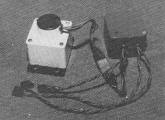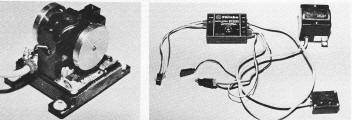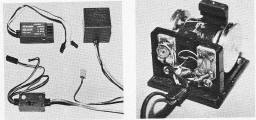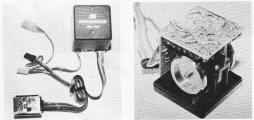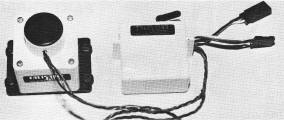Helicopter Gyro's 1980's
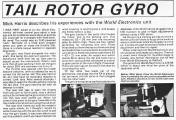
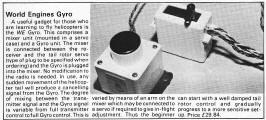 World Engines 1980 electro-mechanical 'rate' gyro - adjustable gain
World Engines 1980 electro-mechanical 'rate' gyro - adjustable gain
Commercially introduced to the UK market in 1980 by World Engines; the World Electronics fully contained unit did not now require the tail rotor servo to be modified. As can be seen the gyro mixer unit used a 'servo' case and retained the output arm and feedback potentiometer wired into the gain circuit and by connecting an additional servo to this arm the gain could be adjusted in flight. Compared to 1974 when the Kavan gyro was the same price as a good 45 size engine, the price of this unit was now significantly reduced and cost £30 compared to £50 for a good 40-45 engine.
RCM&E Gyro - Article from Jan 1982 of the DIY gyro based on the mechanics set of the WE gyro; this gyro based on the WE mechanics now incorporates full tail authority to remove the disadvantages of the WE gyro. This means that full movement of the tail rotor servo is available to the pilot and the gyro only reduces this once a rotation has started. I built one of these for my collective Morley Hughes 300 and it really helped as I could not keep the tail still otherwise. Another addition is also the facility to change the gyro gain directly from the transmitter and thus removes the need for an extra servo.
Gyro's 1983
Gyro survey - Article from Jan edition of RCM&E on the currently available Gyro's on the UK market.
Of note is the differing approaches to monitoring the helicopter movement and whilst the above all use mechanical gyros, WE and Futaba use a potentiometer to detect movement whilst Sanwa uses an infra-red LED with light sensitive resistor and JR uses a hall effect transistor. Full details of their operation is in the article.
Of interest is the final note in the report covering the USA produced 'Watson' stabiliser which is based on vibrating crystals; the first of what was later to be known as Piezo gyro's. Expensive as would be for leading technology and outside of the USA, near enough an unknown quantity as one was obviously not available for the review. It was to be another decade before these became cheap enough for popular use.
Another manufacturer JMW also noted to produce a Gyro (as noted in a 1983 model review) but no details held.
RCM&E Gyro update - Article from April covering the upgrade to make the RCM&E gyro suitable for larger models. The original gyro design sensitivity was low which suited the high sensitivity of small models but when fitted to larger 60 size machines there was not enough gain available without losing tail authority. This upgrade incorporated a pre-amplifier so as to increase the sensitivity without a loss of tail authority.

